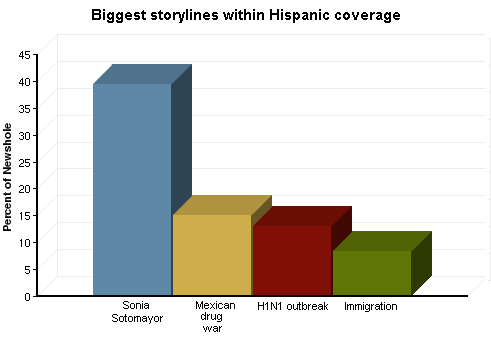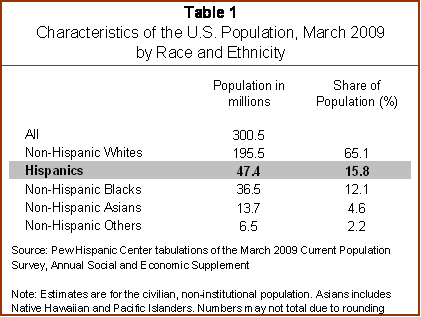Events Drive the Narrative
[1]

A study of more than 34,000 news stories that appeared in major media outlets finds that most of what the public learns about Hispanics comes not through focused coverage of the life and times of this population group but through event-driven news stories in which Hispanics are one of many elements.
From February 9 to August 9, 2009, only a fraction of stories contained substantial references to Hispanics—just 645 out of 34,452 studied. And only a tiny number, 57 stories, focused directly on the lives of Hispanics in the U.S., according to a media content analysis done jointly by the Project for Excellence in Journalism and the Pew Hispanic Center, both of which are projects of the Pew Research Center.
[2]
Immigration, which from 2006 through 2008 had been heavily debated in Congress and on the political campaign trail, was the subject of fewer than one in ten stories involving Latinos, a reflection of the degree to which the issue largely fell off the radar during the early months of the Obama Administration.
[3]
Among the key findings:
- During the six months examined, 2.9% of the news content studied contained substantial references to Hispanics.[4] That was more attention than any other group studied except for Muslims. Nearly all of the Muslim coverage involved foreign affairs, while the majority of Hispanic coverage concerned domestic issues and events.
- The nomination of Sonia Sotomayor made up the largest share of this Hispanic-related news, 39%, more than twice than of any other storyline. The Mexican drug war came second at 15%; the outbreak of H1NI flu (with its origin in Mexico City) was third, at 13%.
- Immigration, the number four topic, accounted for just 8.4% of the coverage involving Hispanics during these six months. When immigration was discussed, however, Hispanics were the group mentioned most often. Looking at all of the news about immigration, 34% referenced Hispanics, 10 times that of any other ethnic group.
- In the small portion of coverage that dealt with the experiences of Hispanics living in the U.S., the most common storyline was the effect of the recession. Next was the immigrant experience, after that was population growth and changing demographics, and then the question of fair treatment and discrimination.
- Looking at Hispanic figures mentioned in the news, Justice Sotomayor received far more coverage than anyone else. She was a lead newsmaker in 30% of all stories with a Hispanic element.[5] The only other people to garner even one percent of the total were leaders of Latin American countries: ousted Honduran president Manuel Zelaya (1.7%), Venezuelan president Hugo Chávez (1.4%), and Mexican president Felipe Calderón (1.1%).
- The degree to which Hispanics are covered in the news varied by media sector. Newspapers gave them the most attention, with Hispanic references in 4.3% of the front-page coverage studied. Hispanics were least likely to be referenced on cable television, appearing in 1.9% of the newshole studied. (Newshole is the percent of total time on TV and radio and space online or in print studied.)
The Population PictureSince 1990 the U.S. Hispanic population has more than doubled, increasing from 21.9 million to 47.4 million in 2009. And, according to the Pew Hispanic Center, it is projected to nearly triple in size to 129 million by 2050, when nearly one-in-three (29%) Americans are expected to be Hispanic (Passel and Cohn, 2008a). This growth has also broadened across the U.S. According to U.S. Census data, between 2000 and 2007 the Hispanic population grew in 3,000 of the nation’s 3,141 counties. As of 2007, the majority of Hispanics (60.2%) were born in the U.S. (Pew Hispanic Center, 2009a). Nearly two-thirds (64.3%) of all Hispanics identify their ancestor’s country of origin as Mexico. This is followed by 9.1% who say they are of Puerto Rican origin, 3.5% who say they are of Cuban origin, 3.2% who say they are of Salvadoran origin, and 2.6% who say they are of Dominican origin (Pew Hispanic Center, 2009b).  |
FOOTNOTES: 1. U.S. Population Projections, Pew Research Center, February 11, 2008.
2. Our definition of “Hispanics” includes anyone from a Spanish-speaking Latin American country or Spain. It also included people referred to with terms that traditionally apply to Hispanics, such as “Latino/a” or “Chicano/a.”
3. In any given week, our coding universe includes a total of eight radio shows: 3 news programs and 5 talk shows. However, during this six-month period, our lineup of radio talk programs changed as we switched between Randi Rhodes’ program and Stephanie Miller’s show. Both of these programs were a part of this study. (For details, see our News Index Methodology.)
4. Percentages in this report are based on newshole, measured as time on TV and radio and space online or in print. For this analysis we studied a total of 815.62 broadcast hours and 6.9 million words across 34,452 stories.
5. In our coding, “lead newsmaker” refers to a person mentioned in over half of a given news story or segment.